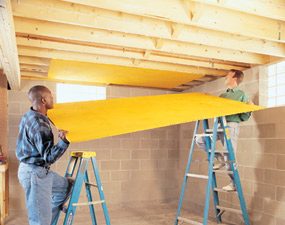Are you tired of feeling like you’re walking on a trampoline every time you step into your home? Bouncy floors are a common problem, especially in older houses, but they can be fixed! Here’s a comprehensive guide to help you identify the cause of the bouncy floors and provide step-by-step instructions on how to fix it.

Image: www.finehomebuilding.com
What Causes Bouncy Floors?
Bouncy floors are often caused by a lack of support beneath the subfloor. The subfloor is the layer of wood or plywood that lies beneath the finished flooring material, such as hardwood, carpet, or tile. When the subfloor is not properly supported, it can sag and bounce, causing the finished flooring to bounce as well.
Other causes of bouncy floors include:
- Loose joists: Joists are the horizontal beams that support the subfloor. Over time, joists can become loose, causing the subfloor to sag.
- Damaged joists: Joists can also be damaged by water, insects, or other factors. This can weaken the joists and cause the subfloor to bounce.
- Inadequate subfloor thickness: The subfloor should be at least 1 inch thick to provide adequate support for the finished flooring. A subfloor that is too thin will be more likely to sag and bounce.
How to Fix Bouncy Floors
Fixing bouncy floors can be a challenging task, but it is possible to do it yourself with the right tools and materials. Here are the steps involved:
- Identify the cause of the bounce. The first step is to determine what is causing the bouncy floors. Check the joists for looseness or damage, and inspect the subfloor for any signs of sagging or damage.
- Repair or replace the joists. If the joists are loose, tighten them using joist hangers or framing nails. If the joists are damaged, they will need to be replaced.
- Install additional support for the subfloor. If the subfloor is sagging, you can install additional support by adding blocking between the joists. Blocking is a piece of wood that is cut to fit between the joists and screwed into place.
- Replace the subfloor. If the subfloor is damaged or too thin, it will need to be replaced. Use a subfloor that is at least 1 inch thick and make sure it is properly supported by the joists.
- Install the finished flooring. Once the subfloor is repaired or replaced, you can install the finished flooring. Make sure the finished flooring is properly nailed or glued to the subfloor.

Image: tutorsuhu.com
How To Fix Bouncy Floors
Tips for Preventing Bouncy Floors
Once you have fixed the bouncy floors, there are a few things you can do to prevent them from coming back:
- Keep the humidity in your home at a moderate level. High humidity can cause wood to expand and buckle, which can lead to bouncy floors.
- Avoid overloading the floors with heavy furniture or equipment.
- Spread the weight of heavy furniture evenly across the floor.
- Inspect the floors regularly for any signs of damage.
By following these tips, you can keep your floors looking and feeling their best for years to come.